| Formation | 1969 |
|---|---|
| Founder | Andrew Sheppy |
| Purpose | Support rare breeds and revive interest in them in the UK |
| Location |
|
Region served | United Kingdom |
Secretary | Patricia Fieldhouse |
| Website | http://www.rarepoultrysociety.com and http://www.rarepoultrysociety.org.uk |
The Rare Poultry Society, established in 1969, is a British breed club devoted to the protection and promotion of rare poultry breeds, which the Society defines as breeds that do not have their own breed club in the United Kingdom. [1] The society's quarterly newsletter has been used as the source material for a number of books on rare breeds in the United Kingdom. [2]
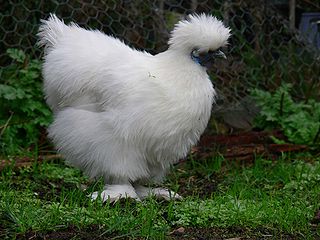
The Silkie is a breed of chicken named for its atypically fluffy plumage, which is said to feel like silk and satin. The breed has several other unusual qualities, such as black skin and bones, blue earlobes, and five toes on each foot, whereas most chickens only have four. They are often exhibited in poultry shows, and appear in various colors. In addition to their distinctive physical characteristics, Silkies are well known for their calm, friendly temperament. It is among the most docile of poultry. Hens are also exceptionally broody, and care for young well. Though they are fair layers themselves, laying only about three eggs a week, they are commonly used to hatch eggs from other breeds and bird species due to their broody nature.
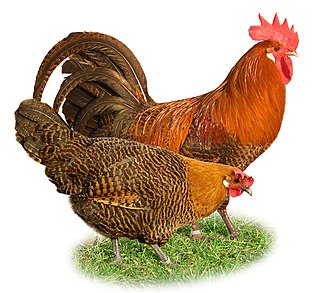
The Braekel or Brakel is a traditional Belgian breed of chicken. It is thought to have originated in the area of Brakel, in the Flemish province of East Flanders, for which it is named. There is a bantam version of the Braekel. The Campine of the United Kingdom derives from it.
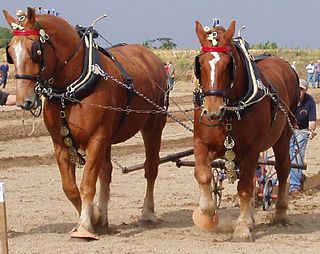
The Suffolk Horse, also historically known as the Suffolk Punch or Suffolk Sorrel, is an English breed of draught horse. The breed takes the first part of its name from the county of Suffolk in East Anglia, and the name "Punch" from its solid appearance and strength. It is a heavy draught horse which is always chestnut in colour, traditionally spelled "chesnut" by the breed registries. Suffolk Punches are known as good doers, and tend to have energetic gaits.

The Dorking is a British breed of domestic chicken. It is named for the town of Dorking, in Surrey in southern England.

The Indian Game is a British breed of game chicken, now reared either for meat or show. It originated in the early nineteenth century in the counties of Cornwall and Devon in south-west England. It is a heavy, muscular bird with an unusually broad breast; the eggs are brown.

The Pekin Bantam is a British breed of bantam chicken. It derives from birds brought to Europe from China in the nineteenth century, and is named for the city of Peking where it was believed to have originated. It is a true bantam, with no corresponding large fowl. It is recognised only in the United Kingdom, where the Cochin has no recognised bantam version; like the Cochin, it has heavy feathering to the legs and feet. The Entente Européenne treats the Pekin Bantam as equivalent to the bantam Cochin.

The Sussex is a British breed of dual-purpose chicken, reared both for its meat and for its eggs. Eight colours are recognised for both standard-sized and bantam fowl. A breed association, the Sussex Breed Club, was organised in 1903.

The Scots Dumpy is a traditional Scottish breed of chicken. It is characterised by very short legs, so short that the body is a few centimetres from the ground; as in other breeds of creeper chicken, this chondrodystrophy is caused by a recessive lethal allele. The Dumpy has at times been known by other names, among them Bakie, Corlaigh, Crawler, Creeper and Stumpy. There are both standard-sized and bantam Scots Dumpies. It is one of two Scottish breeds of chicken, the other being the Scots Grey.

The Old English Game is a British breed of domestic chicken. It was probably originally bred for cockfighting. Two different standards are recognised by the Poultry Club of Great Britain: Carlisle Old English Game and Oxford Old English Game. There is also an Old English Game bantam.

The Magpie is a British breed of domestic duck. It has distinctive black and white markings reminiscent of the European magpie, and is a layer of large eggs.

The Norfolk Grey is a utility breed of chicken that originated near the city of Norwich, in Norfolk, England, in around 1910. The breed was originally created by Frederick W Myhill of Hethel, Wymondham under the name Black Maria. It is a rare breed which is currently considered to be at risk by the Rare Breeds Survival Trust.

The Lohmann Brown is a variety of chicken, raised specifically for egg-laying productivity. It is of crossbreed origin, selectively bred from lines of Rhode Island breed and White Rock breeds. They start to lay at about 19 weeks, producing up to 320 eggs to an age of 72 weeks. Eggs are laid nearly daily, normally during the morning time].

The Sebright is a British breed of bantam chicken. It is a true bantam – a miniature bird with no corresponding large version – and is one of the oldest recorded British bantam breeds. It is named after Sir John Saunders Sebright, who created it as an ornamental breed by selective breeding in the early nineteenth century.
The Nankin Bantam or Nankin is a British bantam breed of chicken. It is a true bantam, a naturally small breed with no large counterpart from which it was miniaturised. It is of South-east Asian origin, and is among the oldest bantam breeds. It is a yellowish buff colour, and the name is thought to derive from the colour of nankeen cotton from China.
The Ixworth is an English breed of white domestic chicken. It is named for the village of Ixworth in Suffolk, where it was created in 1932. It was bred as fast-growing high-quality meat breed with reasonable laying abilities.
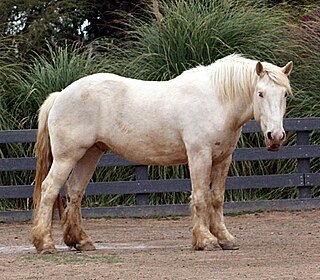
In modern agriculture, a rare breed is a breed of poultry or livestock that has a very small breeding population, usually from a few hundred to a few thousand. Because of their small numbers, rare breeds may have a threatened conservation status, and they may be protected under regional laws. Many countries have organizations devoted to the protection and promotion of rare breeds, for which they each have their own definition. In botany and horticulture, the parallel to rare animal breeds are heirloom plants, which are rare cultivars.
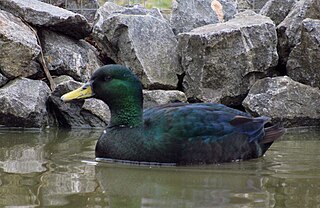
The East Indie or Black East Indian is an ornamental breed of domestic duck. It is a bantam breed, and is thought to have originated in the United States.

The British Lop is an old pig breed native to the United Kingdom. A large, white pig, it is named for its large ears which hang over its face. The breed was originally developed as an amalgamation of several local lop-eared breeds in England, and came to be known as the British Lop in the 1960s.
The Poultry Club of Great Britain is a registered charity founded in 1877. Its stated purpose is to "safeguard the interests of all pure and traditional breeds of poultry including chickens, bantams, ducks, geese and turkeys".
The Modern Langshan is a breed of chicken derived from the Croad Langshan. Though today it is rarely seen, the breed was at one time fairly popular.